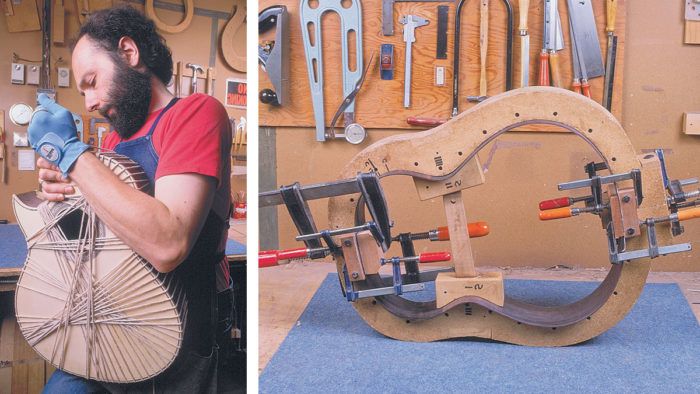
Synopsis: William “Grit” Laskin says making a guitar body is simple and straightforward, though it may seem like half woodworking and half magic. Here, he offers a brief look at how an instrumentmaker relates to the structural, visual, and eventually auditory beauty that is a guitar. He explains the most convenient way to bend guitar sides, patiently pressing the wood around a bending iron. He discusses frame assembly, tapering the sides, binding and purfling the decorative strips, and winding rope around the body to clamp during assembly. Side information by Wad4e Hampton Miller talks about using an electric blanket to bend wood.
A guitar body is a hollow box that epitomizes balance: The precise symmetry of the curves, the compromises between strength and lightness, the artful fitting of minimal glue joints; all these elements combine in what at first glance seems to be half woodworking and half magic. Yet, taken step by step, making a guitar body is fairly straightforward.
Briefly, the process is as follows: The thin sides are bent to the shape of a mold, a plywood or particleboard form that surrounds the instrument in the early stages and acts as a template to ensure symmetry and accuracy (see photo, next page). With the sides inserted in the mold, mahogany endblocks are glued in place at the top and bottom of the body to span the joints where the two sides butt together. The glued-up rim, or frame, is removed from the mold and the top endblock, or heel block, is dovetailed to receive the neck of the instrument.
Next, linings—wooden strips that both stabilize the frame and increase glueline area—are glued around the inside edges at the top and bottom of the frame. The guitar’s soundboard, or top, and its back are braced with supporting strips of wood on the inside to make them stiffer, then glued to the instrument. Finally, narrow strips called binding and purfling are let into rabbets cut on the top and bottom edges of the body. This completes the basic “box,” the body.
In a magazine, I can’t possibly hope to give you a complete how-to for making an instrument—for that, I referenced a number of books in my first article (FWW #67), which covered body shape, the woods used and stock preparation. Here then is another brief look at how an instrumentmaker relates himself to the structural, the visual, and eventually auditory, beauty that is a guitar.
Bending sides
The most convenient way to bend guitar sides is to heat them until the wood plasticizes, apply pressure by hand to form the curve, then let the wood cool to set the bend. Once bent, the sides are immediately in a workable, glueable state.
You’ll need to rig up what I call a bending iron—a hollow metal tube clamped or bolted in place with a heat source inside.
From Fine Woodworking #69
For the full article, download the PDF below:
Fine Woodworking Recommended Products

Compass

Dividers

Stanley Powerlock 16-ft. tape measure




















Log in or create an account to post a comment.
Sign up Log in